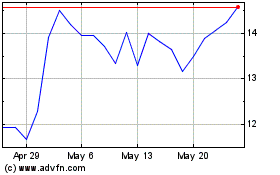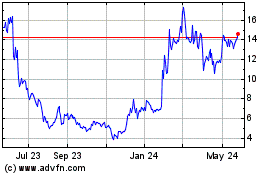PepGen Inc. (Nasdaq: PEPG), a clinical-stage biotechnology company
advancing the next generation of oligonucleotide therapies with the
goal of transforming the treatment of severe neuromuscular and
neurological diseases, today announced that the U.S. Food and
Drug Administration (FDA) has lifted the full clinical hold and
cleared the Company’s Investigational New Drug Application (IND) to
initiate the FREEDOM-DM1 Phase 1 study of PGN-EDODM1 in patients
with myotonic dystrophy type 1 (DM1) in the U.S.
“We have worked closely with the FDA to resolve their questions
expeditiously and are pleased that the clinical hold on our DM1
program in the United States has been lifted. Our novel PGN-EDODM1
approach targets the toxic RNA species responsible for the disease,
and the strength of our Enhanced Delivery Oligonucleotide (EDO)
safety preclinical package has enabled us to launch this study in
both the U.S. and internationally at doses that we believe could
provide a clinically meaningful benefit to patients. We are very
pleased after review of our existing safety data that the FDA
agreed with our proposed starting dose of 5 mg/kg, moving up to 10
mg/kg and 20 mg/kg,” said James McArthur, Ph.D., President and CEO
of PepGen.
As previously communicated, the Company opened FREEDOM-DM1 in
Canada in September of this year. FREEDOM-DM1 is a randomized,
double-blind, placebo-controlled, single ascending dose (SAD)
study, designed to assess PGN-EDODM1 safety and tolerability,
correction of mis-splicing of transcripts, and clinical functional
outcome measures. Sites in both the U.S. and Canada will evaluate
PGN-EDODM1 in 3 cohorts of 5 mg/kg, 10 mg/kg, and 20 mg/kg dose
levels. The decision to advance to the next dose level will be
contingent upon the evaluation of safety data derived from previous
dose cohorts.
Dr. McArthur added, “In a preclinical DM1 mouse model, where EDO
technology achieved oligonucleotide muscle concentrations of 6 nM
of PGN-EDODM1, we observed 76% reversal of myotonia and 68%
correction of mis-splicing. This was increased to 99% correction of
both measures following multiple doses. Based on these preclinical
results, we anticipate proof-of-concept data in patients in 2024,
including transcript splicing and clinical outcome measures, at the
5 mg/kg PGN-EDODM1 dose level in DM1 patients. With clearance of
our IND from the FDA, we are eager to open study sites in the U.S.
to accelerate the development of PGN-EDODM1 for individuals
worldwide living with DM1.”
The Company expects to obtain proof-of-concept data, including
transcript splicing and clinical outcome measures, as well as
safety data, for DM1 patients in the FREEDOM-DM1 clinical study in
2024. The Company also anticipates proof-of-concept data, including
exon skipping and dystrophin data, as well as safety data, at the 5
mg/kg PGN-EDO51 dose level for exon 51 amenable DMD patients in the
CONNECT1-EDO51 clinical study in mid-2024. The Company continues to
expect its cash and cash equivalents to be sufficient to fund
currently planned operations into 2025.
About PGN-EDODM1
PGN-EDODM1 is an investigational candidate designed to deliver a
peptide-conjugated antisense oligonucleotide (ASO) to restore
cellular function. DM1 is caused by an expansion of CUG repeats
that form hairpin loops in the DMPK RNA, resulting in sequestration
of the MBNL1 protein, a key RNA processing factor. The
sequestration of MBNL1 results in downstream mis-splicing events
and aberrant expression of many proteins that play a critical role
in muscle and other systemic functions (e.g. endocrine,
gastrointestinal, central nervous system). By specifically blocking
the toxic CUG repeats, the goal of PGN-EDODM1 is to liberate MBNL1
protein and to restore functional downstream splicing and muscle
and other systemic functions.
About Myotonic Dystrophy Type 1 (DM1)
Myotonic dystrophy type 1, or DM1 (also known as Steinert’s
disease), is a progressively disabling, life-shortening genetic
disorder. DM1 is the most prevalent form of the disease and
generally the most severe. DM1 affects an estimated 40,000 people
in the U.S., and 70,000 in the EU. The average life expectancy for
people living with DM1 is 45-60 years old. People living with DM1
typically present with myotonia (stiff or contracted muscles),
muscle weakness, and cardiac and respiratory abnormalities. Many
people living with DM1 also experience excessive daytime
sleepiness, fatigue, and issues with gastrointestinal or cognitive
dysfunction that significantly affect their quality of life.
About PGN-EDO51
PGN-EDO51, PepGen’s lead clinical candidate for the treatment of
Duchenne muscular dystrophy (DMD), utilizes the Company’s
proprietary Enhanced Delivery Oligonucleotide (EDO) technology to
deliver a therapeutic oligonucleotide that is designed to target
the root cause of this devastating disease. PGN-EDO51 is designed
to skip exon 51 of the dystrophin transcript, an established
therapeutic target for approximately 13% of DMD patients, thereby
aiming to restore the open reading frame and enabling the
production of a truncated, yet functional dystrophin protein. In
preclinical studies, PepGen observed that treatment of non-human
primates with PGN-EDO51 resulted in greater levels of exon-skipping
when compared in head-to-head studies against a molecule that we
believe is structurally equivalent to the most clinically-advanced
peptide-conjugated oligonucleotide therapeutic candidate, which
could translate to higher levels of dystrophin production in
patients. PGN-EDO51 also exhibited the highest level of exon 51
skipping in primate skeletal muscles, including the diaphragm,
reported for any approved therapeutic or known development
candidate, based on cross-trial comparisons of publicly available
data with preclinical PGN-EDO51 data. In humans, in a single
ascending dose study, PGN-EDO51 also exhibited the 20-fold higher
exon 51 skipping than naked oligo following a single dose, based on
cross-trial comparisons of publicly available data with clinical
PGN-EDO51 data.
About Duchenne Muscular Dystrophy (DMD)
Duchenne muscular dystrophy (DMD) is an X-linked recessive
muscle-wasting disease that predominantly affects males. This
debilitating disease is caused by genetic mutations in the gene
encoding dystrophin, a protein critical for healthy muscle
function, and is one of the most prevalent rare genetic diseases,
with an incidence rate of approximately one in every 3,500 to 5,000
male births. DMD is characterized by progressive muscle weakness,
which leads to patients losing the ability to walk, a loss of upper
body function, cardiac issues and difficulties breathing. DMD is
invariably fatal by young adulthood. Despite significant advances
in treatments for this devastating disease, current therapies are
limited by poor delivery to muscle tissue and have yet to establish
meaningful clinical benefit for DMD patients.
About PepGen
PepGen Inc. is a clinical-stage biotechnology company advancing
the next-generation of oligonucleotide therapies with the goal of
transforming the treatment of severe neuromuscular and neurological
diseases. PepGen’s Enhanced Delivery Oligonucleotide, or EDO,
platform is founded on over a decade of research and development
and leverages cell-penetrating peptides to improve the uptake and
activity of conjugated oligonucleotide therapeutics. Using these
EDO peptides, we are generating a pipeline of oligonucleotide
therapeutic candidates that are designed to target the root cause
of serious diseases. For additional information, visit
www.pepgen.com.
Forward-Looking Statements
This press release contains forward-looking statements within
the meaning of the Private Securities Litigation Reform Act of
1995, as amended. These statements may be identified by words such
as “aims,” “anticipates,” “believes,” “could,” “estimates,”
“expects,” “forecasts,” “goal,” “intends,” “may,” “plans,”
“possible,” “potential,” “seeks,” “will,” and variations of these
words or similar expressions that are intended to identify
forward-looking statements. Any such statements in this press
release that are not statements of historical fact may be deemed to
be forward-looking statements. These forward-looking statements
include, without limitation, statements regarding the therapeutic
potential and safety profile of our product candidates including
PGN-EDO51 and PGN-EDODM1, our technology, including our EDO
platform, the design, initiation and conduct of clinical trials,
including expected timelines, regulatory interactions, including
development pathway for our product candidates, and our financial
resources and cash runway.
Any forward-looking statements in this press release are based
on current expectations, estimates and projections only as of the
date of this release and are subject to a number of risks and
uncertainties that could cause actual results to differ materially
and adversely from those set forth in or implied by such
forward-looking statements. These risks and uncertainties include,
but are not limited to risks related to: delays or failure to
successfully initiate or complete our ongoing and planned
development activities for our product candidates, including
PGN-EDO51 and PGN-EDODM1; our ability to enroll patients in our
clinical trials; our interpretation of clinical and preclinical
study results may be incorrect, or that we may not observe the
levels of therapeutic activity in clinical testing that we
anticipate based on prior clinical or preclinical results; our
product candidates may not be safe and effective or otherwise
demonstrate safety and efficacy in our clinical trials; adverse
outcomes from our regulatory interactions, including delays in
regulatory review, clearance to proceed or approval by regulatory
authorities with respect to our programs, including clearance to
commence planned clinical studies of our product candidates,
including PGN-EDO51 and PGN-EDODM1, or other regulatory feedback
requiring modifications to our development programs; changes in
regulatory framework that are out of our control; unexpected
increases in the expenses associated with our development
activities or other events that adversely impact our financial
resources and cash runway; and our dependence on third parties for
some or all aspects of our product manufacturing, research and
preclinical and clinical testing. Additional risks concerning
PepGen’s programs and operations are described in our most recent
annual report on Form 10-K and quarterly report on Form 10-Q that
are filed with the SEC. PepGen explicitly disclaims any obligation
to update any forward-looking statements except to the extent
required by law.
Investor ContactLaurence WattsGilmartin
GroupLaurence@gilmartinir.com
Media ContactSarah SuttonArgot
Partnerspepgen@argotpartners.com
PepGen (NASDAQ:PEPG)
Historical Stock Chart
From Jan 2025 to Feb 2025

PepGen (NASDAQ:PEPG)
Historical Stock Chart
From Feb 2024 to Feb 2025
